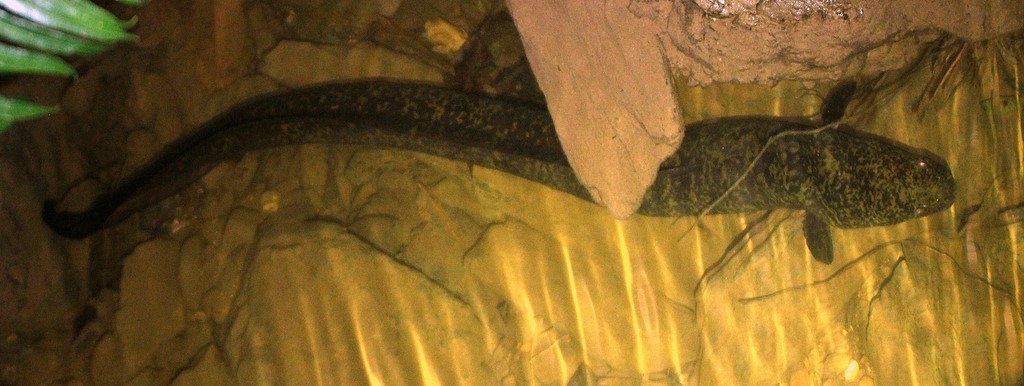ANGUILLA MARMORATA - (QUOY & GAIMARD, 1824)
Picture courtesy of: Amaury Durbano
Actinopterygii (Gigaclass) > Actinopteri (Superclass) > Teleostei (Class) > Anguilliformes (Order) > Anguilloidei (Suborder) > Anguillidae (Family) > Anguilla (Genus)
Anguille marbrée, Madagascar mottled eel, Giant mottled eel, Giant long-finned eel, Enguia gigante, Anguilla moteada gigante, Madagaskar-bontpaling, Reus-bontpaling, Ô-unagi, オオウナギ, 무태장어, 毛里求斯鰻鱺, 花鰻鱺,
Synonymes
Anguilla fidjiensis (Günther, 1870)
Anguilla hildebrandti (Peters, 1881)
Anguilla hildebrandti (Sauvage, 1891)
Anguilla johannae (Günther, 1867)
Anguilla labrosa (Richardson, 1848)
Anguilla marmolata (Quoy & Gaimard, 1824)
Anguilla mauritiana (Bennett, 1831)
Muraena manillensis (Bleeker, 1864)
--------------------------
Description
Vertebrae: 100-110. Head rounded; Snout depressed; Lower jaw protruded; Gill openings small; Scales matted-like under skin; Pectoral fin rounded; Pelvic fin absent. Distance between verticals at dorsal-fin origin and anus 14-19% in TL. Lips thick. Band of minute teeth on vomer narrows considerably at its middle. Max. length: 70.0 cm TL male, 200.0 cm TL female. Max. published weight: 20.5 kg. Max. reported age: 40 years. Depth range: 1 - 400 m.
Color
Juveniles are greyish to orange with marbling is less visible.
Adults body brown speckles scattered on back, sides and fins; Yellow between speckles and edge of pectoral fin; Belly white or pale blue.
Etymology
Anguilla: from Latin, anguis = snake. Referring to snake-like body shape (tautonymous with Muraena anguilla Linnaeus, 1758).
marmorata: from Latin, marmoratus = marbled, covered or encrusted with marble, having been marbled. Referring to greenish-brown to black marbling on its dorsal surface.
Original description: Anguilla marmorata Quoy & Gaimard, 1824 - Type locality: Waigeo (Waigiou), Indonesia.
Distribution
Indo-West Pacific: South Africa, East Africa, Mayotte (France), Madagascar and Mascarenes (La Réunion, Mauritius, Rodrigues), east to Caroline Islands (Micronesia), Mariana Islands, Gambier Islands and Marquesas Islands (French Polynesia), north to southern Japan, south to South Australia and New Caledonia.
Biology
Can be found in running waters within a range of 0-200 m altitude, estuaries and seas as young. Found in lowland rivers as well as upland tributaries. While in river, the sex gland does not develop. But in winter when they move from the stream to river mouth, the sex gland begins to develop as mature individuals go to deep sea to breed. The spawning grounds are deep sea gullies among the south of the Philippines, east of Indonesia and Papua New Guinea. Are active at night, feeding on a wide range of prey, especially crabs, frogs and fish. Thought to breed east of Madagascar where the young are wafted to the East Coast by ocean currents.
Similar species
Last update: 4, June 2023
Anguille marbrée, Madagascar mottled eel, Giant mottled eel, Giant long-finned eel, Enguia gigante, Anguilla moteada gigante, Madagaskar-bontpaling, Reus-bontpaling, Ô-unagi, オオウナギ, 무태장어, 毛里求斯鰻鱺, 花鰻鱺,
Synonymes
Anguilla fidjiensis (Günther, 1870)
Anguilla hildebrandti (Peters, 1881)
Anguilla hildebrandti (Sauvage, 1891)
Anguilla johannae (Günther, 1867)
Anguilla labrosa (Richardson, 1848)
Anguilla marmolata (Quoy & Gaimard, 1824)
Anguilla mauritiana (Bennett, 1831)
Muraena manillensis (Bleeker, 1864)
--------------------------
Description
Vertebrae: 100-110. Head rounded; Snout depressed; Lower jaw protruded; Gill openings small; Scales matted-like under skin; Pectoral fin rounded; Pelvic fin absent. Distance between verticals at dorsal-fin origin and anus 14-19% in TL. Lips thick. Band of minute teeth on vomer narrows considerably at its middle. Max. length: 70.0 cm TL male, 200.0 cm TL female. Max. published weight: 20.5 kg. Max. reported age: 40 years. Depth range: 1 - 400 m.
Color
Juveniles are greyish to orange with marbling is less visible.
Adults body brown speckles scattered on back, sides and fins; Yellow between speckles and edge of pectoral fin; Belly white or pale blue.
Etymology
Anguilla: from Latin, anguis = snake. Referring to snake-like body shape (tautonymous with Muraena anguilla Linnaeus, 1758).
marmorata: from Latin, marmoratus = marbled, covered or encrusted with marble, having been marbled. Referring to greenish-brown to black marbling on its dorsal surface.
Original description: Anguilla marmorata Quoy & Gaimard, 1824 - Type locality: Waigeo (Waigiou), Indonesia.
Distribution
Indo-West Pacific: South Africa, East Africa, Mayotte (France), Madagascar and Mascarenes (La Réunion, Mauritius, Rodrigues), east to Caroline Islands (Micronesia), Mariana Islands, Gambier Islands and Marquesas Islands (French Polynesia), north to southern Japan, south to South Australia and New Caledonia.
Biology
Can be found in running waters within a range of 0-200 m altitude, estuaries and seas as young. Found in lowland rivers as well as upland tributaries. While in river, the sex gland does not develop. But in winter when they move from the stream to river mouth, the sex gland begins to develop as mature individuals go to deep sea to breed. The spawning grounds are deep sea gullies among the south of the Philippines, east of Indonesia and Papua New Guinea. Are active at night, feeding on a wide range of prey, especially crabs, frogs and fish. Thought to breed east of Madagascar where the young are wafted to the East Coast by ocean currents.
Similar species
- Anguilla australis (Richardson, 1841) - Reported from New Caledonia. Long cylindrical bodies, and continuous dorsal, caudal and anal fins with the dorsal fin originating above or slightly in front of the anal fin.
- Anguilla megastoma (Kaup, 1856) - Reported from New Caledonia - Link to the species (here).
- Anguilla obscura (Günther, 1872) - Reported from New Caledonia. Varying from silver or yellowish to dark brown on the dorsal and lateral surfaces, becoming paler ventrally. The dorsal fin originates before the anus, just in front of, or level with the anal fin origin, and the jaws reach beyond the eye.
- Anguilla reinhardtii (Steindachner, 1867) - Reported from New Caledonia - Link to the species (here). Adults and elvers are distinctly mottled or marbled with olive-green to brown markings, and a paler underside. Mouth large, horizontal, usually reaching just beyond eyes; Gill openings small, just forward of lower half of pectoral fin bases; Dorsal, caudal and anal fins united to form one continuous fin.
Last update: 4, June 2023
